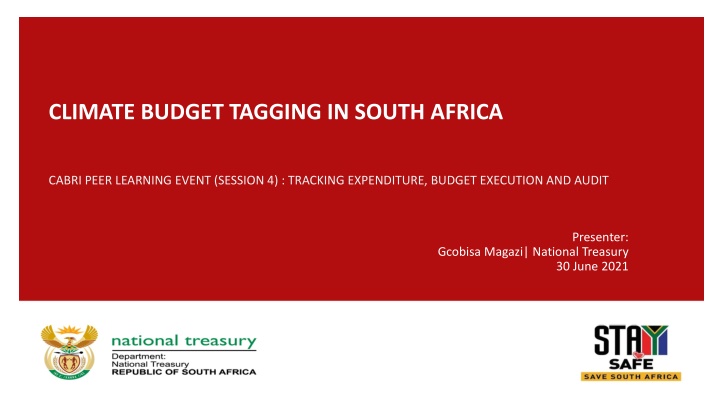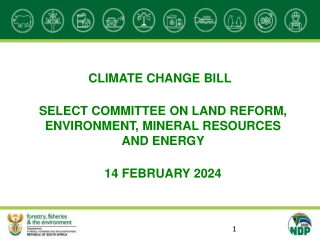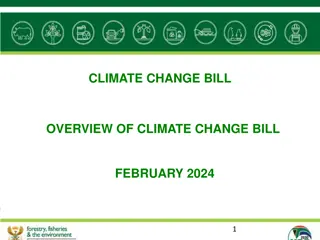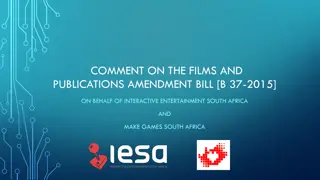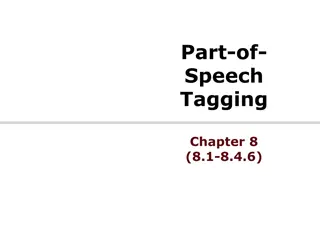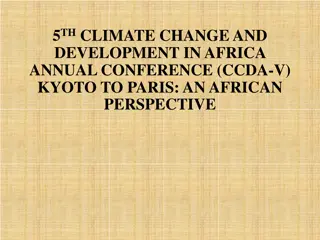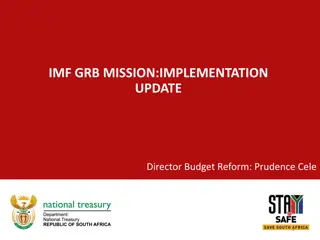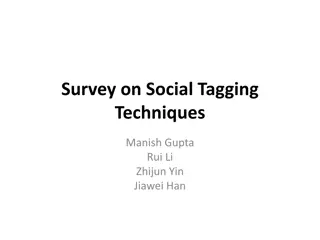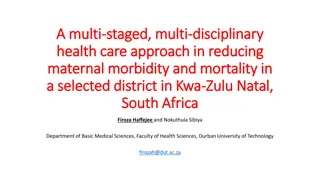CLIMATE BUDGET TAGGING IN SOUTH AFRICA
In South Africa, climate change is a key priority affecting socio-economic development. The National Development Plan advocates for a transition to a sustainable, low-carbon economy. With ambitious plans to transition the economy by 2050, South Africa has committed to emission reductions and aligning with international climate change agreements. Implementing sectoral policies and strategies requires mobilizing resources and integrating climate change responses into fiscal frameworks and budget processes.
Download Presentation

Please find below an Image/Link to download the presentation.
The content on the website is provided AS IS for your information and personal use only. It may not be sold, licensed, or shared on other websites without obtaining consent from the author.If you encounter any issues during the download, it is possible that the publisher has removed the file from their server.
You are allowed to download the files provided on this website for personal or commercial use, subject to the condition that they are used lawfully. All files are the property of their respective owners.
The content on the website is provided AS IS for your information and personal use only. It may not be sold, licensed, or shared on other websites without obtaining consent from the author.
E N D
Presentation Transcript
CLIMATE BUDGET TAGGING IN SOUTH AFRICA CABRI PEER LEARNING EVENT (SESSION 4) : TRACKING EXPENDITURE, BUDGET EXECUTION AND AUDIT Presenter: Gcobisa Magazi| National Treasury 30 June 2021
CONTENTS South African Climate Change Policy Context Requirements for Implementation of Sectoral Policies and Strategies The Role of the National Treasury Process of developing a climate change tagging framework for South Africa -Approach and Design Parameters -CBT Project Process and Timelines -CBT Pilot Process Climate Budget Tagging in South Africa : Slide 2
SOUTH AFRICAN CLIMATE CHANGE POLICY CONTEXT NATIONAL DEVELOPMENT PLAN CLIMATE CHANGE Climate change is increasingly recognised as a transversal priority affecting socio-economic development by the South African government Chapter 5 of the National Development Plan (NDP) advocates for a transition to an environmentally sustainable, climate-resilient, low- carbon economy and just society . These have also been translated into the current iteration of the MTSF MOBILISE ADDITIONAL RESOURCES FOR TRANSITION SECTORAL POLICIES AND STRATEGIES South Africa has set an ambitious plan to transition the economy from a carbon intensive economy to a low-carbon, inclusive growth and development trajectory by 2050 , SA-LEDS 2020. INTERNATIONAL COMMITMENTS Nationally Determined Contribution (NDC) to the UN Framework Convention on Climate Change (UNFCCC), SA has committed to an emission trajectory that peaks during 2020- 2025, plateau for a decade, and then decline in absolute terms CLIMATE RISKS AND INTEGRATION INTO FISCAL AND ECONOMIC MODELLING The rapid transition that will be required presents a potential risk to economic growth and sustainable development if not managed properly Currently, SA is updating NDC for submission to the UNFCCC, building up to COP 26. The NDC enables South Africa to position itself internationally at the same time as addressing domestic development requirements for a suitably ambitious and just climate transition CONVERGENCE POINT IN PUBLIC POLICY AND SECTORAL RESOURCE PLANNING National Climate Change Response White Policy Paper (2011) highlights the need to use macro-fiscal and budgetary frameworks to implement policy, address risks and opportunities and change behaviours around climate change 3
REQUIREMENTS FOR IMPLEMENTATION OF SECTORAL POLICIES AND STRATEGIES Complementary sectoral policy measures towards decarbonising the economy e.g. green transport strategy, IRP 2019,NEES, carbon tax phase I &II) - require mobilisation of additional resources and revenue recycling measures Supporting these policy interventions, measures and programmes require a range of fiscal policy levers and financing instruments, reorientation of public finances and incentive regimes across the different sectors of the economy: Strengthen mechanism to mainstream climate change response into the intergovernmental fiscal budgetary process to integrate the climate change response programmes at national, provincial and local government and development finance institutions and state-owned entities. Mobilisation of Mobilisation of resources resources (public, private and concessional finance with multilateral DFIs Tagging climate-related expenditure lines is a useful starting point for understanding whether spending is aligned with needs, given climate risks and vulnerabilities facing different sectors and society A diagnostic assessment of National Treasury underway highlights climate budget tagging as one of the potential areas in which the National Treasury could strengthen the response to climate change 4
CLIMATE BUDGET TAGGING IN SOUTH AFRICA CBT is a tool for tracking and monitoring climate change-relevant decisions in public budgets CBT objectives in SA - Influencing budget and policy decisions at all levels to be more climate relevant - Improving the effectiveness of climate relevant budget and policy decisions - Assessing the national gap and enabling accountability for climate change responsibilities and reporting on climate change strategies, plans and commitments. CBT system structured is centred on these main design parameters - What will be the approach and coverage of the system - How will climate relevance be defined, classified and scored, and how will associated expenditure be weighted - How will the tags be generated in the South African public resource management cycle, and how will the information be used/reported - How will the system be governed 6
DESIGN PARAMETERS: APPROACH Key consideration in the CBT approach for South Africa - South African intergovernmental fiscal system presents characteristics of fiscal decentralisation (assignment and distribution of expenditure responsibilities across the three spheres of government, different budget formats) - Complications may arise owing to variations in budgeting and accounting reporting systems between national and provincial government (cash-based) vs local government (accrual based) and fiscal financial year cycles - The intention is to implement a CBT system across the three spheres of government, given the distribution of expenditure responsibilities in key climate change sectors, but to phase implementation appropriately - CBT will use South African modified definition that incorporates just transition . It will follow a hybrid approach in terms of scoring, weighing expenditure relevance taking into account both the objectives and net assessments of expenditure - Imbedded in government planning, budget preparation, financial management and reporting systems - Institutionalisation of the CBT across the PFM system may be for a period of +/- 5 years 7
DESIGN PARAMETERS : COVERAGE Across sphere coverage: climate relevance of expenditures will be tagged in all three spheres of government, in key climate change sectors - agriculture, water, energy, environmental protection and health. Coverage at provincial and local level phased: local most likely to follow IFMIS and mSCOA Within sphere coverage: within a target five-year period, roll-out to sectors with high climate relevance will be prioritised across all three spheres, but it is likely that coverage will not stretch to all local governments. Coverage of public entities: public entity expenditures will be tagged as part of South Africa s CBT, given the role that some entities play relative to climate change (such as Eskom, transport and infrastructure entities and the water boards) and the volume of tax revenues. PEs present added complexities to tagging due system configurations and demand in capacities , tagging of public entities likely to form part of Phase II of CBT (stress-testing approach with selected entities) Include climate negative programmes: CBT in South Africa will include relevant expenditures that occur in programmes that are otherwise harmful to the environment or society (including climate negative programmes) as some countries do, but will tag these expenditures differently so that climate expenditure reports can differentiate. Include donor-financed expenditures: While donor-financed expenditure is a small share of government expenditure overall, it is likely to be a much more significant share of climate relevant expenditures. The CBT system should allow for tagging donor expenditures, for optimal use by the South African Government of the system. The approach to be followed will be determined in consultation with the International Development Cooperation Chief Directorate of National Treasury, and pilot in some sites. Other : CBT will use South African modified definition that incorporates justtransition . It will follow a hybrid approach in terms of scoring, weighing expenditure relevance taking into account both the objectives and net assessments of expenditure. 8
DESIGN PARAMETERS: CC RELEVANCE 1 What definitions to demarcate CC relevance Define mitigation and adaptation in line with the Just Transition, but tag to extract information according to OECD definitions Explore how to do this in material development, and test in pilots Plan to identify expenditure on climate related loss and damage, but for later implementation What information will be used to identify climate relevance? Explicit or implicit? CC Policy links? Pilot the use of standing reference lists to identify climate relevant objectives/benefits Consider both explicitly stated and implied relevance Use additional layers of classification National and sphere policy relevance Direct and supporting expenditures 9
DESIGN PARAMETERS: CC RELEVANCE 2 Benefit versus objectives-based assessment of degree of relevance - Objectives-based: degree to which objectives are relevant to climate mitigation or adaptation - Benefits-based: difference between benefits expenditure generates under business as usual versus in climate change - Both use methodologies to assess consistently Key decision, as base system has to be one or other - Stakeholder preferences on one or the other are mixed - Pilots will therefore test both (rapid benefit-based assessment) If objectives-based, will use adjusted Rio Markers approach to score - Principal, Significant, Minor, Not targeted - Then weight according to score Appetite in SA to include benefits-based assessment because of interest in effectiveness - Base system is an option - In addition, a one- or two-way link to climate change impact assessments 10
KEY DESIGN PARAMETERS: LOCATION IN SA RESOURCE MANAGEMENT CYCLE System location For main budget Have to think about harmonisation with other tagging in place For donor funding Within the ODA management system discussion with IDC Tagging process In planning and budgeting cycle First identification by spending units, validation centrally (at national provincial and local level) Governance of system not yet discussed after pilots Expectation that CBT information will feature in budget process Discussion of how and with what purpose is purpose of NT pilot Reporting Expectation is some level of reporting in budget documentation But also, regular separate reports Tags are identified, developed off-system --> then uses system to tag / generate reports Annual review after first development Imbedded in planning, budgeting, execution systems Works with programmes/sub-programmes and votes/sub-votes 11 11
CBT PROJECT PROCESS Jul Apr Oct Jan Dec Materials Consultation (from October 2020) Main design parameters Material development Capacity needs Assessment Design Possibility of Phase 2, to work on CBT in PEs For pilots 2ndphase broader, post pilots Capacity needs assessments Note on Cost and Benefits of CBT To May 2021 Consultation with key stakeholders E.g. DFFE, DPME, NPCS, DCoG, DoT, DoWS, DoE, provincial Treasuries, departments, metros via Advisory Committee and directly With NT units via NTWG on CC and directly Raise awareness Consult on likely costs and benefits of CBT Consultation & awareness raising workshops Pilots Report 10 pilot sites 4 sectors Roll-out Action Plan and Governance Recs 1 2 exchanges with other CBT countries Nat, Prov, Gov Piloting` Peer Exchange Synthesise all information for Roll-out Action plan Governance recommendations Review Climate Budget Tagging in South Africa Slide No 12 12
PILOT PROCESS 9 pilot sites (3 sectors in 3 spheres) -3 sectors because of impact on CC (energy) and CC impact (agriculture and water) -Limited resources 10th process involves working with NT to determine how CBT will sit in budget process, and stress-testing readiness and capacity in NT -Follow up on discussions on detailed design Piloting approach will differ between spheres, with municipal pilots being more complex BUT, same CBT methodology in all South Africa Climate Budget Tagging Project -- Slide No 13 13 Climate Budget Tagging in South Africa Slide No 13
THANK YOU 14
